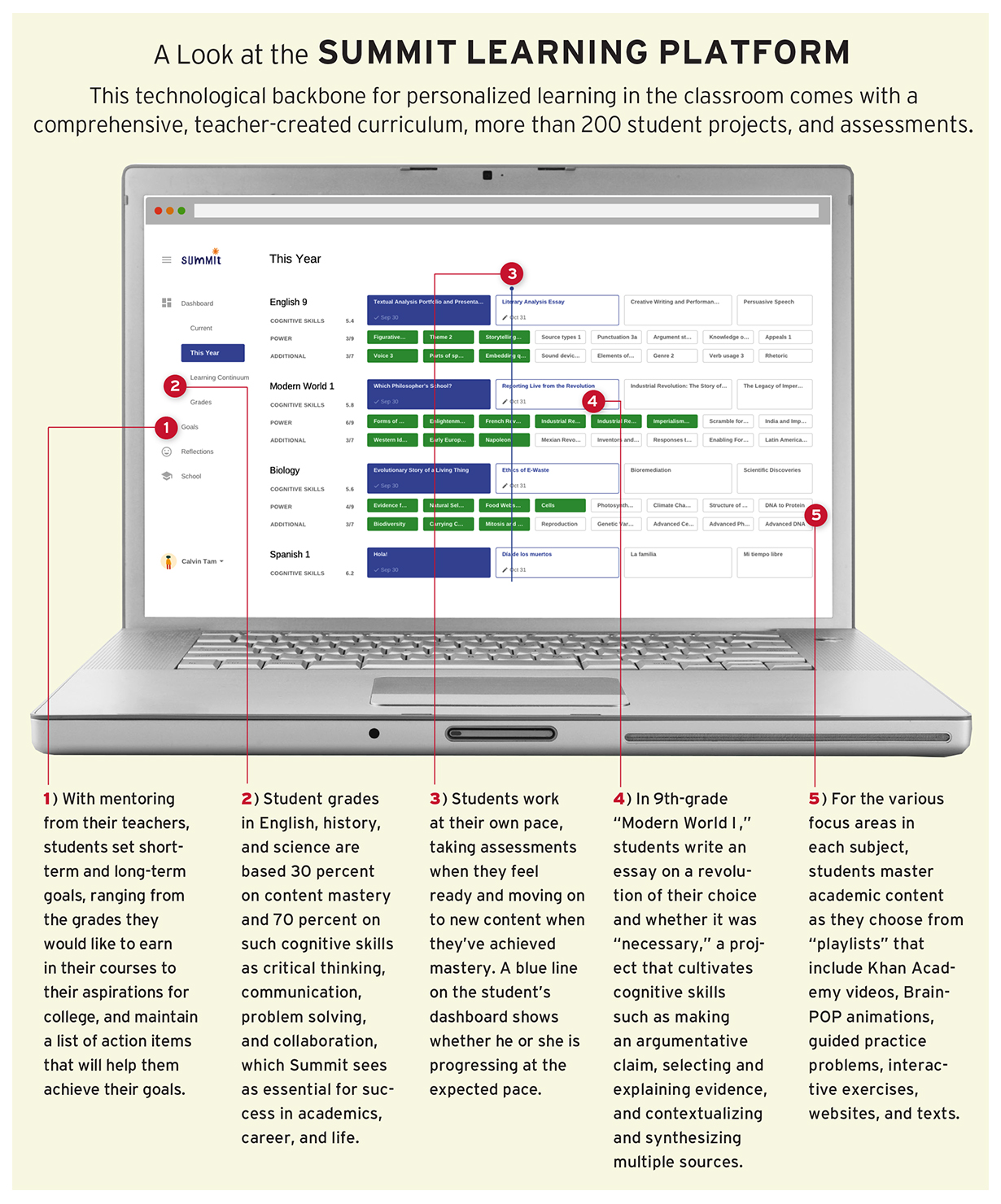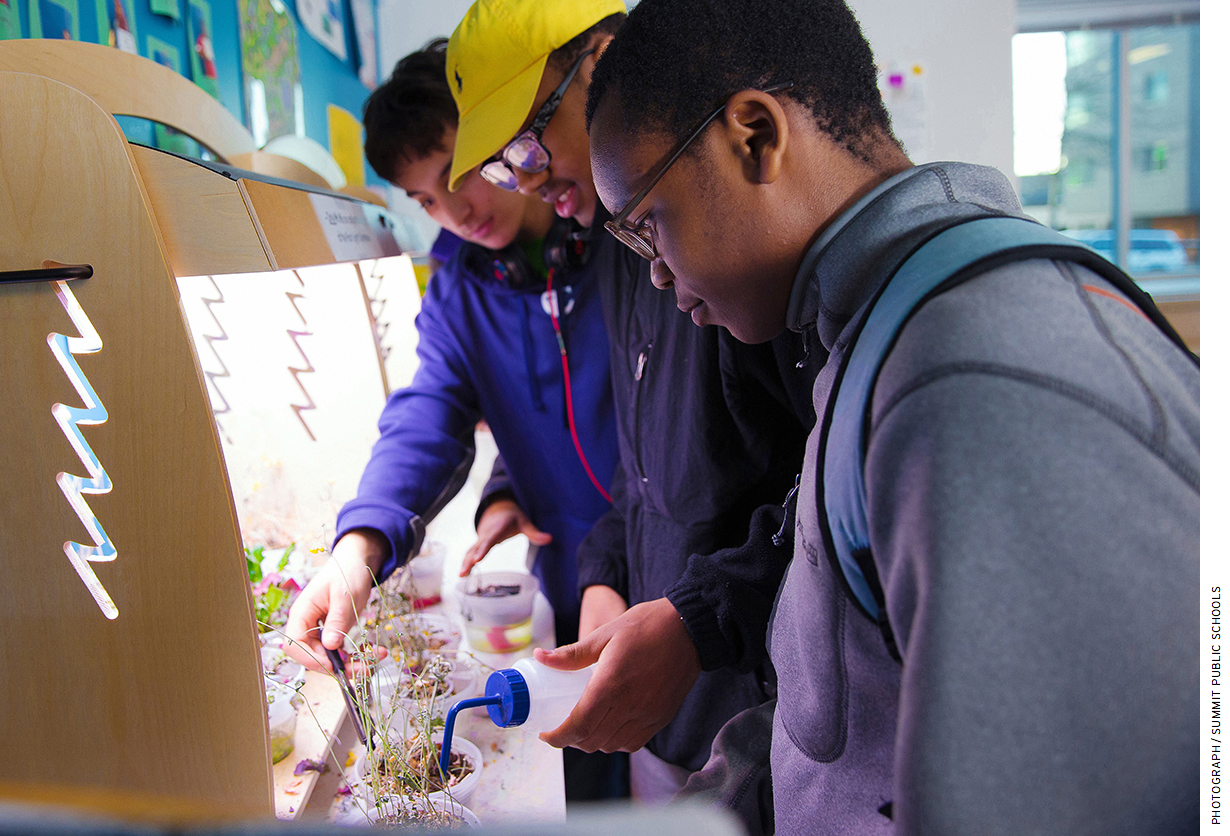
How does a thermometer work? A group of 7th graders discuss their ideas.
Nearby, a student named Ferdinand is modifying a swallow so the bird can survive in the video-game fantasy world he’s designed on the computer. “I’m giving it spiked feathers,” he says with a grin. “My world has insane predators.”
Some students are working in pairs. Others are on their Chromebooks. The classroom is abuzz with activity.
“They know what to do,” says Brandy Holton, who teaches 7th-grade science, social studies, and English at the Chicago International Charter School (CICS) Irving Park, which serves grades K–8. “That never would have happened before.”
What accounts for the change? The charter’s middle school is one of 130 schools nationwide piloting the Summit Learning Program (SLP), developed—and offered entirely free—by Summit Public Schools, a high-performing charter network based in California. Summit’s eight schools, two of them in Washington State, are known for an approach that emphasizes both project-based and self-paced learning as well as the development of cognitive skills. In 2015, the network started sharing its model with schools throughout the country in an effort to improve their methods and spread their ideas.
The tech mainstay of Summit’s model is an online platform that the network developed with engineering help from Facebook. It comes loaded with a comprehensive, teacher-created curriculum, ideas for student projects, and assessments for grades 5 through 12 in core academic subjects.
Students master academic content through personalized learning, choosing from “playlists” made of such learning tools as Khan Academy videos, BrainPOP animations, guided practice problems, interactive exercises, websites, and texts. They take tests when they feel ready, moving on to new content when they’ve achieved mastery. A blue line on the student’s dashboard shows whether he or she is progressing at the expected pace.
Technology is only part of Summit’s model. Students spend most of their time learning cognitive skills and concepts through individual and collaborative “deeper learning” projects. Ninth graders create scientific experiments to measure the impact of technology waste on the environment; 7th graders explore the Civil Rights movement by examining injustices in their own communities.
Teachers work one-on-one with students, helping them set short-term and long-term goals and develop “habits of success,” such as self-management, responsible decision making, and persistence.
Compared to her students of past years, this year’s pupils are much more mature and self-directed by midyear, says Holton, a fourth-year teacher. They no longer act as if “the only way to learn is through the teacher.”
Holton has changed, too. “I step back and let the students do the heavy lifting,” she says.
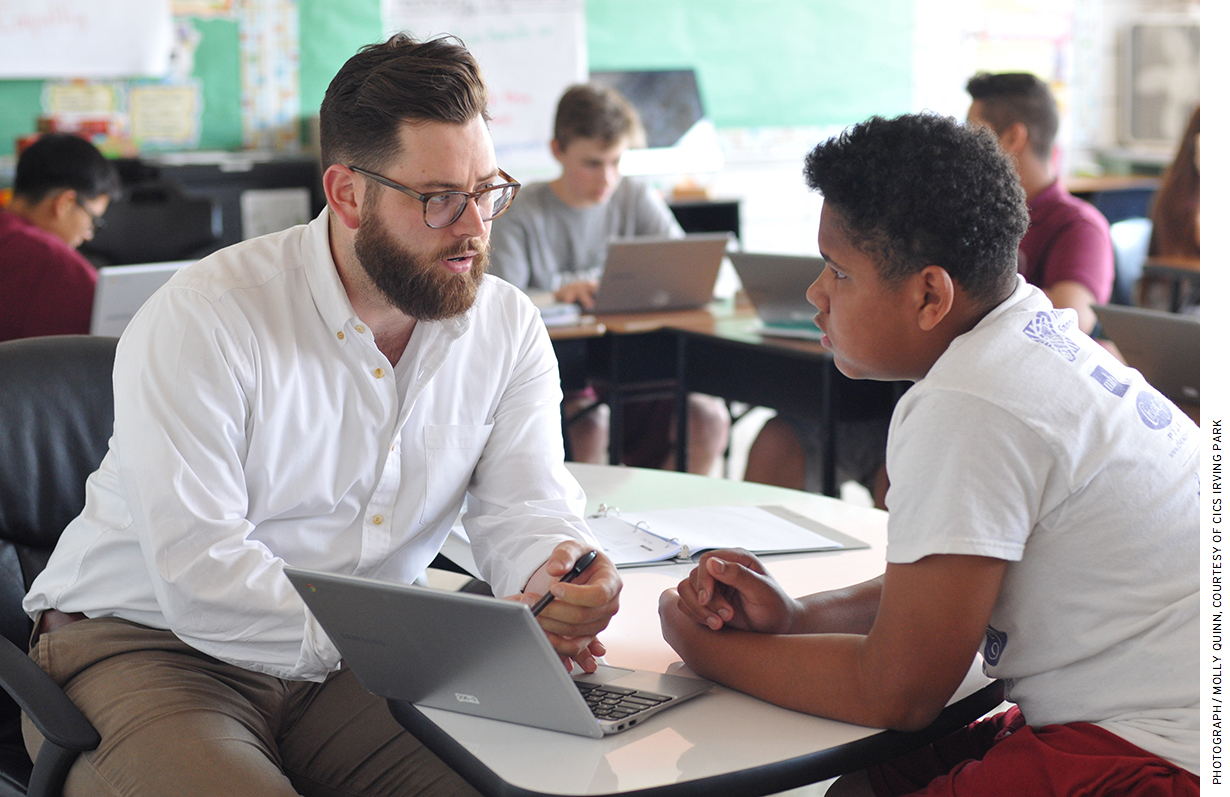
Preparing for Change
In the summer of 2016, CICS Irving Park sent its middle-school teachers to Summit’s Everest Public High School in Redwood City, California, for a week of intensive training. This, too, is offered free of charge, as is mentoring for teachers and school leaders and technical support throughout the school year.
In exchange for the free services, partner schools are testing how the platform works in a variety of settings, adapting it to their needs, and sharing their improvements. About 70 percent of participants are traditional public schools, 25 percent are charters, and 5 percent are private schools, said Lizzie Choi, chief program officer at Summit, who runs the SLP. There are pilot schools in 27 states, from Rhode Island to California. Some serve prosperous communities, others enroll primarily immigrants, and a few serve only special-needs students. Summit started with 19 partner schools in 2015–16 and added more than 100 new schools the following year. Typically, schools begin by implementing the Summit model at a single grade level, then add another grade the following year.
Schools pledge to use Summit’s teaching model, which has three pillars: project-based learning focused on cognitive skills; self-paced learning to mastery in content areas; and one-on-one mentoring to help students set and meet goals. Student grades in English, history, and science are based 70 percent on cognitive skills, such as critical thinking, communication, problem solving, and collaboration, and 30 percent on content mastery. Math grades are based 30 percent on cognitive skills, 30 percent on mastery of basic concepts and procedures, and 40 percent on students’ ability to apply those concepts when solving complex problems.
As schools implement the SLP, participating teachers from all over the country can collaborate via Facebook—troubleshooting problems, sharing project tweaks, and supporting one another.
“A teacher somewhere will ask: ‘Has anyone had this problem? How did you handle it?’” said Michelle Staack, a math teacher at CICS Irving Park. “It’s a great resource.”
Throughout the school year, Choi said, Summit’s software engineers talk to teachers about their “pain points”—the obstacles and problems they encounter—and try to find solutions.
For instance, when teachers wanted easier ways to design their own curriculum and share it with other teachers, the engineering team changed the platform to make it easier to customize and collaborate, said Sam Strasser, the platform’s chief architect. “Projects are a cornerstone of the Summit learning experience,” he said. “Seeing how important it is for teachers to know their learners, we built a tab [for] projects to help teachers easily see which students need support in which skills.”
Summit’s Beginnings
Summit Public Schools did not start out to be a pacesetter in personalized learning. In 2003, it opened its first school, Summit Prep, which featured traditional college-prep methods and drew the children of affluent Silicon Valley professionals and working-class Mexican immigrants. The 400-student high school in Redwood City—midway between San Francisco and San Jose—became nationally known for its success in sending all its students through Advanced Placement courses and on to college. It was featured in the 2010 film Waiting for Superman and in 2011 was named one of the Top 10 Most Transformative Schools in the country by Newsweek.
However, in 2011, Summit CEO Diane Tavenner was surprised to learn that only 55 percent of Summit graduates had earned a bachelor’s degree in six years. That was close to the national average, but far below what she’d expected.
“Graduates told us, ‘you guys loved us too much,’” recalled Choi, who taught algebra before becoming Summit’s chief program officer. Students were academically prepared but hadn’t learned how to cope with large classes, long research papers, and other college challenges without the close guidance they had enjoyed at Summit.
By 2012, Summit “relaunched” the prep school with a goal of creating “self-directed learners” who could succeed in college.
To begin developing the personalized learning platform, teachers divided the Common Core standards into “focus areas” with (typically) three learning objectives each, a playlist of learning tools, and short assessments. They also designed projects to teach cognitive skills.
The Stanford Center for Assessment, Learning and Equity (SCALE) helped evaluate and refine Summit’s cognitive-skills rubric, ensuring it was aligned to grade-level competencies and standards.
In 2013, Summit hired Strasser, co-founder of an education technology startup called Junyo, to work with teachers on building the platform.
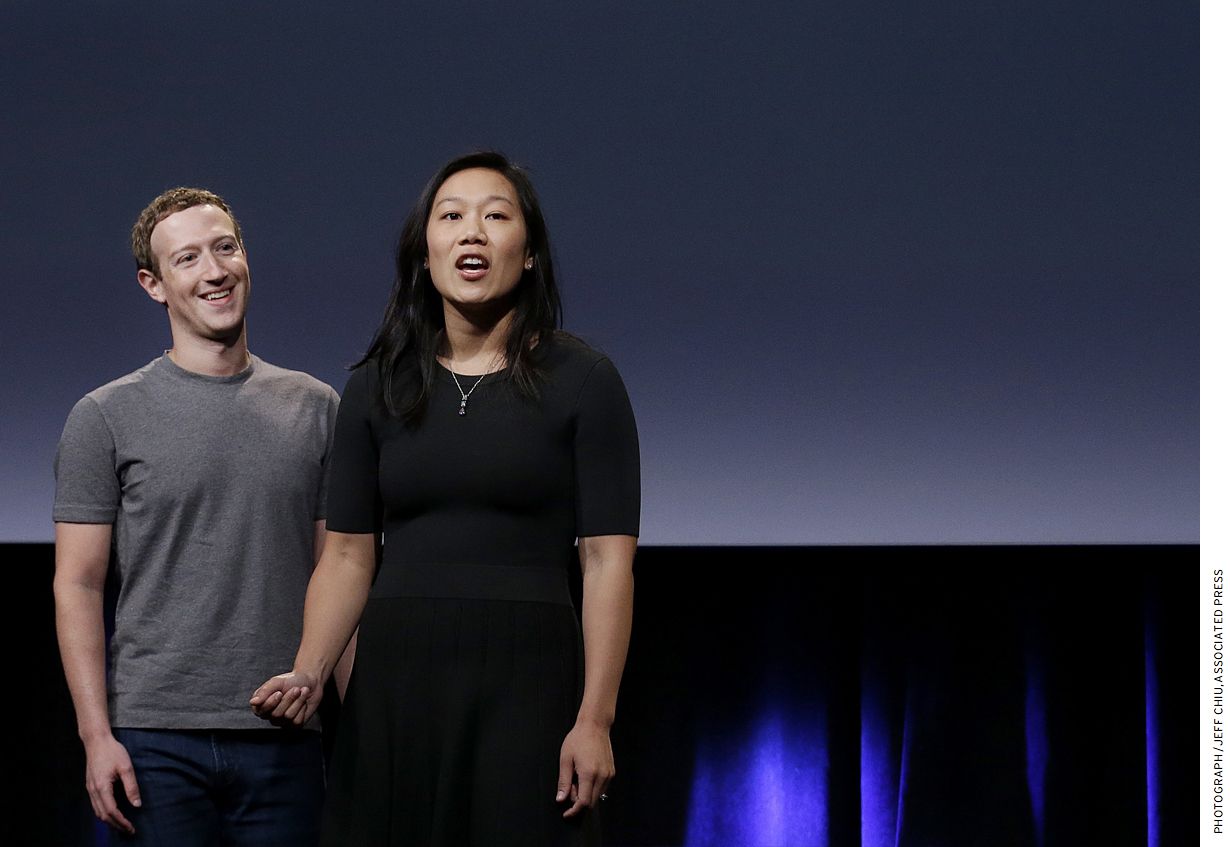
The following year, Facebook CEO Mark Zuckerberg and his wife, Priscilla Chan, visited a Summit school. They were so impressed by its approach that Zuckerberg lent Summit a team of Facebook engineers and product designers to help develop the platform.
In (appropriately) a Facebook post, Zuckerberg has said Facebook and Summit are pledged to abide by “strict privacy controls to protect student data.” Facebook itself has no business plans for personalized learning, Zuckerberg has said, but he is committed to providing the infrastructure for self-directed, personalized learning for free to all U.S. schools.
This year, the Chan Zuckerberg Initiative—the high-tech couple’s foundation—will take over from Facebook as Summit’s engineering partner.
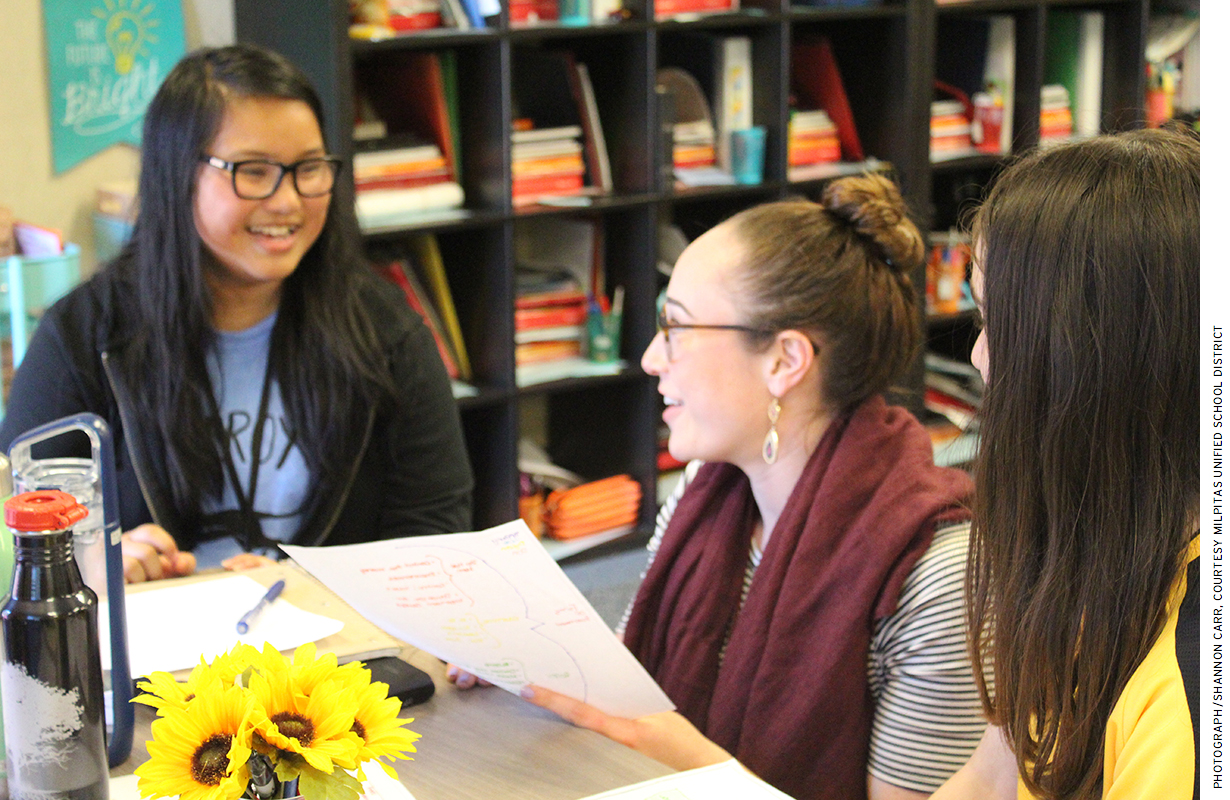
The Summit Way
The Summit Public Schools network now includes eight middle and high schools in the Bay Area and two high schools in Washington State, with a middle/high school slated to open in Seattle in fall 2017. The schools have attracted the attention of another education philanthropist: Bill Gates visited Summit Sierra in Seattle last year and praised what he saw on his “gatesnotes” blog. “At its best, personalized learning doesn’t just let students work at their own pace. It puts them in charge of their own academic growth,” he wrote.
Summit Sierra teacher Aubree Gomez showed Gates how the software lets her track the progress of each student she mentors. She talked with Jerald, a 9th grader, about his science project and his goal of getting straight As.
“He knew exactly what he had to do: which lessons he needed to finish, which tests he needed to take, and how high he needed to score,” wrote Gates. “When students get out in the world, they have to organize their own time, have goals, and realize what they’re behind on. It’s fantastic to see them getting a head start on those skills in school.”
More than 800 miles south of Summit Sierra, in south San Jose, Summit Tahoma high school serves 300 students; about half are eligible for a subsidized lunch and two-thirds are Hispanic. The school inhabits a cluster of gray portable classrooms next to Oak Grove High and, on the outside, doesn’t look like a cutting-edge school.
Inside, in Emily Richey’s 9th-grade English class, students are selecting and reading a nontraditional text, such as a political cartoon, video, or song about a social problem, and writing a paragraph that explains the text’s point.
And in 9th-grade “Modern World I,” Eileen Kim is teaching students to integrate evidence into their argument as they write an essay about the “zombie revolution.” Eventually, students will choose a real revolution—Russian, French, Cuban, Egyptian, Mexican, or Iranian—and write an essay on whether it was “necessary.”
Integrating evidence is one of the cognitive skills the project aims to cultivate, along with developing a theme or central idea, making an argumentative claim, selecting and explaining evidence, and contextualizing and synthesizing multiple sources.
While Summit students spend most of their time working on projects, 20 percent of the day is devoted to Personalized Learning Time (PLT), during which students learn academic content, choosing the digital tools they’ll use to meet their goals.
“PLT is my favorite,” says Ely Villagrana, a 9th grader.
Just as technology facilitates student learning, it also helps teachers connect with students, says Nicholas Kim, the school’s executive. “We have so much clarity about what students know and can do. Teachers know exactly which kids need more help and what they need help with.”
Yamileth Silva appreciates her mentor teacher’s feedback on her poetry. “Not many people want to read a 9th grader’s poetry,” she says with a smile. Her favorite subject is math, though it’s not her strongest, she says. “I like to be challenged.” Her current goals are to earn a B+ in math and to improve her poetry.
Villagrana says his goal is to improve his soccer skills.
“What about college?” asks Kim. “Let’s talk about adding an academic goal.”
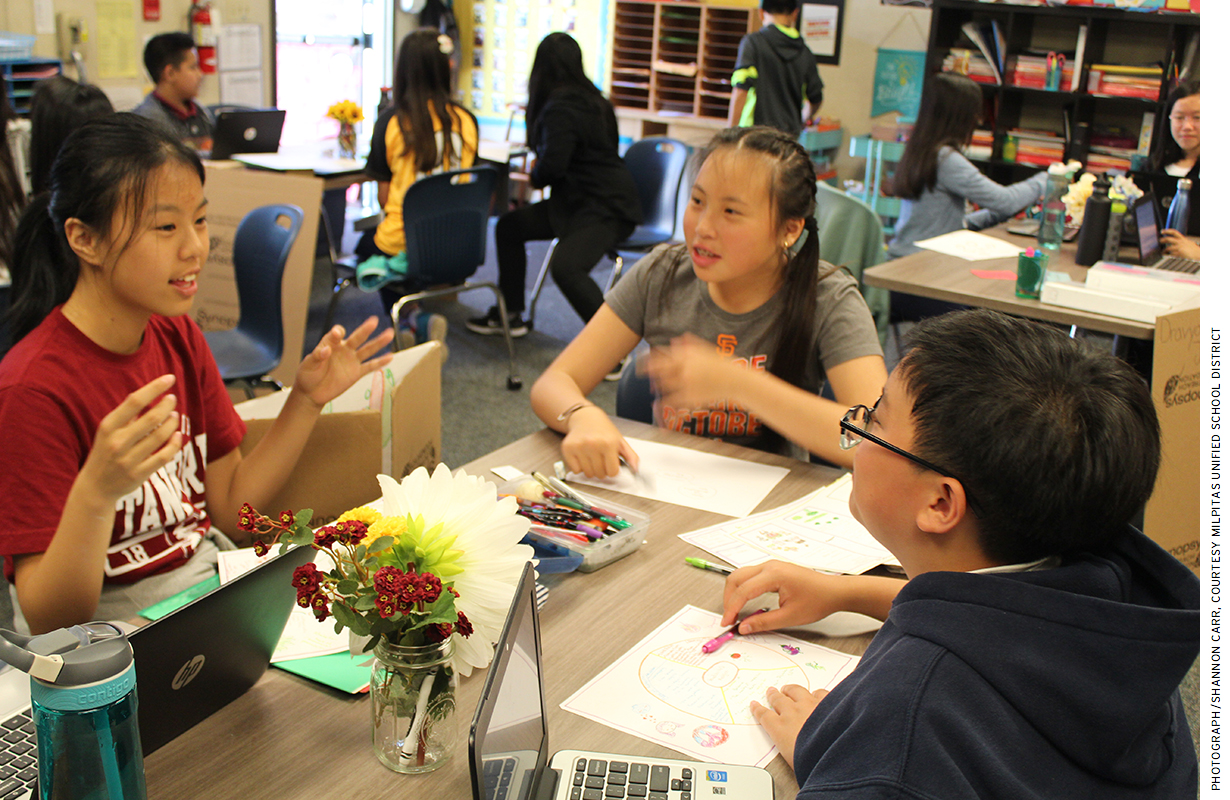
Culture Shifts
Four of the schools that are testing out Summit’s learning program are in the Milpitas Unified School District, just north of San Jose. Once a blue-collar town with a Ford plant (now a shopping mall), Milpitas has gentrified with Silicon Valley. It’s also drawn immigrants from Vietnam, the Philippines, and China, many of whom work in high-tech jobs.
In 2012, then schools superintendent Cary Matsuoka asked principals at all district schools to come up with redesign plans that would integrate technology; use data to inform instruction; allow flexibility in space, time, and student grouping; and center on student learning.
“My teachers said ‘no way,’” recalled Sheila Murphy-Brewer, who was then principal of Marshall Pomeroy Elementary. She asked her staff to study how they might individualize instruction to reach students at different levels. Such extensive customization would be impossible, they concluded: teachers didn’t have the time. That realization motivated them to try blended learning, said Murphy-Brewer. Still, implementing a new way of teaching was “painful.”
By 2013–14, all the district’s schools were using some form of blended learning, but Murphy-Brewer wanted to go further. After seeing personalized learning at Summit Denali, in Sunnyvale, California, she “begged” for a spot in the 2015 summer training. Her school piloted the SLP in the 6th grade during the 2015–16 school year.
Murphy-Brewer saw Summit’s model as a good fit for Pomeroy: Because of the school’s blended-learning pilot, its teachers already had some experience with self-paced learning. Summit’s style of grading would be challenging, but not impossible, since Pomeroy already stressed cognitive skills. And Summit’s Habits of Success meshed with Pomeroy’s character curriculum.
Yet despite these commonalities, the transition to the new model wasn’t easy. Pomeroy had a shorter school day and less flexibility than Summit charter schools did. Teachers were thus given the option of assigning Personalized Learning Time as homework. Mentoring, which is a lynchpin of the program, was new to Pomeroy’s teachers. The SLP calls for weekly mentoring, but the teachers couldn’t find the time for that during the school day. They settled on meeting with each student for 10 minutes every other week.
But the biggest hurdle for teachers, said Murphy-Brewer, was learning to teach to the standards through projects—rather than simply adding a project at the end of a lesson. At first, “teachers saw projects as a time-consuming add-on, not as a way of teaching,” she said. That has begun to change as teachers see that students are capable of learning independently.
Math was particularly problematic. In the first year, teachers had to modify the math projects or “just teach the traditional way,” said Matsuoka. “Math doesn’t lend itself to project-based learning.”
In response, Summit altered its math approach to focus on “concept units” as well as projects. “Summit has a humility,” said Matsuoka. “When something isn’t working, they change it.”
After the first year, growth in English language arts was “exceptional” at Pomeroy and at Joseph Weller Elementary, which also piloted the SLP, said Matsuoka. Math scores remained about the same.
To his delight, students “took ownership of their learning. They were getting things done on time, searching for information. It was magical to see these 11-year-olds acting like adult learners, totally engaged.”
Matsuoka, who became superintendent of Santa Barbara Unified in 2016, plans to use the SLP for a junior high school and a continuation school in his new district.
Pomeroy added 5th grade to the pilot in 2016–17, and teachers at the school continue to adapt the platform. After the first year, two 6th-grade teachers, Deanna Sainten and Sarah Thomsen, spent the summer analyzing the projects provided in the SLP. Some only needed “tweaks,” said Sainten, who’s in her 11th year of teaching. Others “you could tell were written by first-year teachers. They were grandiose.” The two teachers rewrote some projects, adding new tasks and checkpoints. “We created our teaching plan for the year over the summer,” said Sainten.
With students learning subject content at their own pace through the platform, Sainten said she is free to focus on “big-picture teaching.”
“There’s far more discussion and collaboration and more engagement,” she said. “In the past, I was losing so many students on both ends” of the learning spectrum. “They were bored or they were confused.”
That heightened engagement was evident in November 2016 when 6th graders read Long Walk to Water, based on the true story of one of the “lost boys” of Sudan who made it to the United States, then returned to his homeland to found Water for South Sudan. Student teams worked on ways to raise awareness of the need for clean water in South Sudan. They planned fundraising projects, such as recycling water bottles and holding a Christmas toy sale. They donated their profits—$4,500—to help build wells in South Sudan.
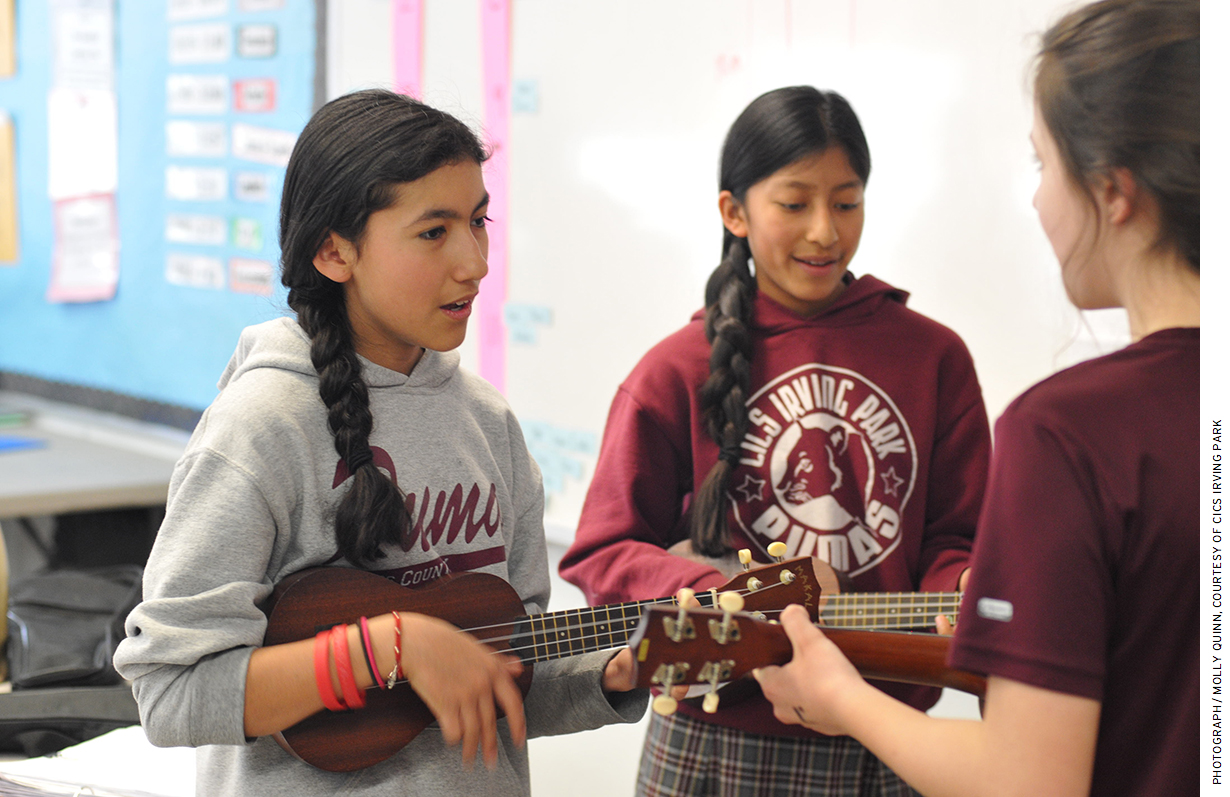
CICS Irving Park
Bringing the SLP to CICS Irving Park also was a challenge. The charter rents a yellow-brick building from the Catholic school next door. Two thirds of its students are Hispanic; 64 percent are eligible for a free or reduced-price lunch.
Irving Park had some experience with blended learning before signing up for the Summit program in 2016, but Karin Breo, the school’s director, was aiming higher. “Our kids have been compliant and high-achieving but not engaged in learning,” she said.
Breo held multiple meetings to explain personalized learning to parents. Teachers liked the idea of mentoring students and holding “office hours” to give students extra help, but, like Pomeroy’s staff, they had trouble fitting it into the school day. “They were mentoring during breakfast, lunch, and PLT,” said Breo. “They came in during winter break to do office hours.” In February, Breo began paying teachers to meet with students after school.
But in other respects, the new model meant fewer demands on teacher time. Brandy Holton used to spend hours every night custom planning lessons for 7th graders at different levels, searching for resources, and creating videos. “It was exhausting,” said Holton. Now, with most tools and materials included in the platform, “I’m re-energized. That teacher guilt is gone.”
Last year, 25 to 30 percent of her students were struggling academically, she estimated. This year, that’s down to 10 to 15 percent. Students are successfully “grappling with this new way of learning. It makes them so much stronger.”
In midyear, students—most of them from Latino families—studied the Aztec empire’s clash with the Spanish conquistadors. They each selected an Aztec character—male or female, merchant, warrior, Montezuma—and researched what their character’s life might have been like in 1520. The next step was to write about one of seven topics from that character’s point of view.
“I’ve never seen students love history like this,” said Holton.
Staack’s math students also are more engaged. When a project required students to plan a hypothetical business, one group devised a scheme for selling giant cupcakes. Another conceived of a food truck affiliated with the Chicago Cubs that would follow the team to away games.
As for the teacher, she’s less stressed. “I don’t have to find resources and design assessments,” said Staack. “It’s all there in one spot.”
This has been the “most rewarding teaching” he’s ever done, said Kevin Kreller, who teaches 8th-grade English. He has more time to give students “real, meaningful feedback” and build relationships.
His students listened to the Serial podcast about a teenager accused of murdering a classmate, analyzed the evidence in Socratic seminars, and wrote opinion papers that impressed Kreller with their thoughtfulness. “They were so focused,” he said. “We’re tapping into their real potential, not just going through the motions.”
Given the success of the middle school pilot, Distinctive Schools, which manages the CICS schools, plans to implement the SLP in the network’s three high schools.
What’s Next?
There is no evidence yet as to whether the Summit approach prepares students to succeed in college better than other methods do; the program is too new. But Summit has reported first-year results for SLP partner schools: Growth on the Northwest Evaluation Association’s Measures of Academic Progress (NWEA MAP) exceeded national averages in reading and, very slightly, in math. Gains were greatest for low achievers, who improved significantly in both subjects.
After one semester of personalized learning, CICS Irving Park analyzed data for 6th-, 7th-, and 8th-grade students. In reading, students in all three grades showed higher growth than they had the previous year; growth in math was similar to the previous year, except for 7th graders, whose improvement was slightly better.
Currently, about 38 percent of Summit’s partner schools are middle schools, 24 percent are high schools, and 13 percent are elementary schools. (The remaining 25 percent have other configurations, such as K–12 or K–8.) Summit is adding content for younger students on the platform, which now covers 5th through 12th grade. It also plans to develop a rating system so teachers can evaluate each other’s curriculum and project ideas.
The SLP’s adaptability may be the key to its future. Because it’s an open-source system, the platform will keep improving, in the view of Mark Kushner, who heads +Impact School, a private Expeditionary Learning high school in Lake Tahoe, California, that uses SLP. “We plan to add new content units, new projects, and new assessments” to share with other SLP schools across the country, said Kushner, a serial school founder and blended-learning innovator.
Across the country, cloud-based personalized learning platforms are moving beyond their founding school networks, wrote Julia Freeland Fisher, director of education research at the Clayton Christensen Institute. In addition to the Summit Learning Platform, others to watch include Matchbook Learning School’s Spark, Brooklyn LAB’s Cortex, AltSchool’s AltSchool Open, and the Gooru learning navigator from Leadership Public Schools.
Summit and AltSchool, which received a Zuckerberg donation, provide integrated learning systems, said Tom Arnett, a Christensen researcher specializing in blended learning. That means “they’ve designed their instruction and their technology together.” But such comprehensiveness comes with advantages and disadvantages: “They’ve made it work in their schools, but how do you specify the professional development and the instructional model so that it works in other school systems?”
By contrast, other platforms are less exhaustive but more modular: “You bring in your content and lesson materials and plug them in,” Arnett said. “It’s more challenging to do that, but it offers greater flexibility” for schools to customize the program to their own needs.
The “future of education is more personalized learning,” Arnett asserted. Not everyone concurs, and educators often disagree on how to define it. Personalized learning is still evolving. Will Summit’s model prove to be the gold standard? According to Arnett, “That remains to be seen.”
Joanne Jacobs is a freelance education writer and blogger (joannejacobs.com) based in California.
This article appeared in the Fall 2017 issue of Education Next. Suggested citation format:
Jacobs, J. (2017). Pacesetter in Personalized Learning: Summit charter network shares its model nationwide. Education Next, 17(4), 16-24.


